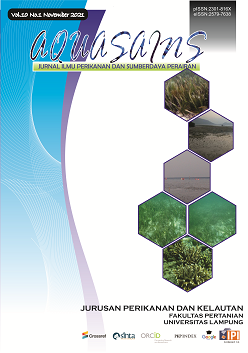Trophic-Saprobic Index Based on Macrozoobenthos Abundance as Indicator of Pollution Status in The Banjir Kanal Barat River.
DOI:
https://doi.org/10.23960/aqs.v10i1.p1015-1022 Abstract View: 298
Abstract View: 298
Abstract
The Banjir Kanal Barat River is one of the major rivers in the Semarang City and there are various activites along the river by the citizen which will give an impact to lead to pollution on water quality. Macrozoobenthos can be used as bioindicator because of it’s low of mobility, easy to catch and identify. The purpose of this study was to determine the community structure of macrozoobenthos, the saprobic index value and to determine the pollution status of The Banjir Kanal Barat River.This research was conducted in June-July 2020 using a purposive sampling technique with a total of three stations. The 1st Station is dredged waters in 2019, the 2nd Station is polluted waters due to chicken farm waste, and the 3rd Stations is polluted waters due to domestic waste.The identification of macrozoobenthos use FAO book (1998) and Conchology.be website.The Calculation of community structure of macrozoobenthos consist of diversity, uniformity, and dominance index.The data analysis in this research are data analysis of community structure of macrozoobenthos and saprobic index. The result showed that the Diversity Index (H’) ranged from 0,98 to 1,17 while the Uniformity Index (e) was between 0,56-0,71 and the Dominance Index (C) ranged from 0,43 to 0,45. There were 8 types of macrozoobenthos, consisting of 1 type from the polysaprobic group, 2 types from the β-mesosaprobic group and 5 types from the non-saprobik group. Based on the calculation of the saprobic index value obtained -0,11 and the Tropic Saprobic Index was -1,07. The pollution status of the Banjir Kanal Barat River is indicated moderate to severe pollution.
Downloads
References
Gaus, I., Haeruddin dan C. Ain 2018 Pemanfaatana Makrozoobentos sebagai Bioindikator Pencemaran Logam Pb dan Cd di Perairan Teluk Semarang. Journal of Maquares 7(1): 9-17
Hellawel, J. M 1986 Biological Indicators of Fresh Water Pollution and Environmental Management. Elsevier Applied Science Publishing, London
Junqueira, M. Vilela, G. Friedrich dan Paulo R. P. de Araujo 2010 A saprobic Index for Biological Assessment of River Water Quality in Brazil (Minas Gerais and Rio de Janeiro States). Environ Monit Assess (163): 545-554
Wulandari, Angela Herma G. R., Sahala Hutabarat dan Churun Ain 2014 Pengaruh Limbah Cair Tahu Terhadap Kelimpahan Makrobenthos di Sungai Elo Magelang. Diponegoro Journal of Maquares Management of Aquatic Resource 3 (4): 1-8

.png)










